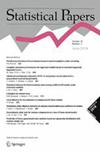因素数量的启发式克里图标准
IF 1.1
3区 数学
Q2 STATISTICS & PROBABILITY
引用次数: 0
摘要
摘要 卡特尔(Multivar Behav Res 1:245-276,1966 年)的启发式方法将因子数确定为树状图中 "陡峭 "与 "不陡峭 "之间的肘点。与此相反,根据定义,在具有相应等值化表面的小交叉点上不存在肘点。我们将这一启发式方法正式化,并提出了一个标准,通过比较克里图下的表面来确定因子的数量。蒙特卡罗模拟显示,我们提出的标准的有限样本属性优于动态因子模型文献中的基准。本文章由计算机程序翻译,如有差异,请以英文原文为准。
An heuristic scree plot criterion for the number of factors
Abstract
Cattel’s (Multivar Behav Res 1:245–276, 1966) heuristic determines the number of factors as the elbow point between ‘steep’ and ‘not steep’ in the scree plot. In contrast, an elbow is by definition absent in points on a hyberbole with corresponding equisized surfaces. We formalize this heuristic and propose a criterion to determine the number of factors by comparing surfaces under the scree plot. Monte Carlo simulations shows that the finite-sample properties of our proposed criterion outperform benchmarks in the dynamic factor model literature.
求助全文
通过发布文献求助,成功后即可免费获取论文全文。
去求助
来源期刊

Statistical Papers
数学-统计学与概率论
CiteScore
2.80
自引率
7.70%
发文量
95
审稿时长
6-12 weeks
期刊介绍:
The journal Statistical Papers addresses itself to all persons and organizations that have to deal with statistical methods in their own field of work. It attempts to provide a forum for the presentation and critical assessment of statistical methods, in particular for the discussion of their methodological foundations as well as their potential applications. Methods that have broad applications will be preferred. However, special attention is given to those statistical methods which are relevant to the economic and social sciences. In addition to original research papers, readers will find survey articles, short notes, reports on statistical software, problem section, and book reviews.
 求助内容:
求助内容: 应助结果提醒方式:
应助结果提醒方式:


